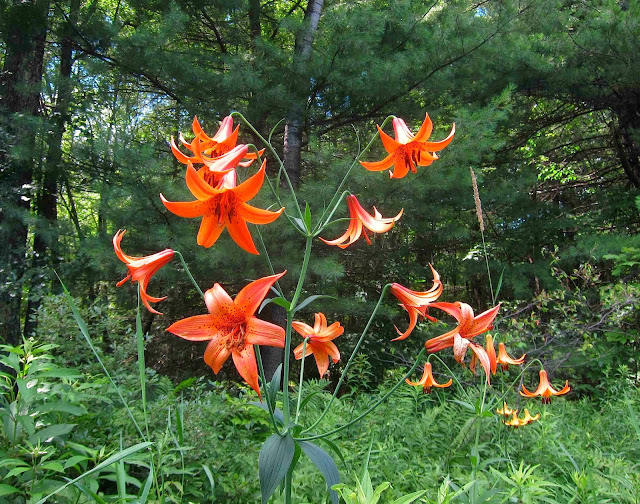For many years, I visited the nearby Bog Meadow Brook Nature Trail to exult in the gorgeous Canada Lilies (Lilium canadense) that used to grow there. They grew there abundantly, in every color this native wild lily is known to grow in. Orange was the most typical color:
And sometimes the orange-flowered specimens produced extravagant numbers of flowers per plant:
Yellow was also a not uncommon flower color:
Red was not a common a color for these lilies, but I found that color occasionally. And sometimes the red ones were red and yellow bi-colored:
These lilies usually grew close to the trail, but occasionally I would see their brilliant flowers glowing like lamps quite a distance away in the forested wetland:
All so gorgeous. And I could count on them always blooming close to the Fourth of July, like silent fireworks, their flowers as bright as bombs-bursting-in-air. So 8 years ago, on July 4, 2017, I headed out to Bog Meadow Brook Nature Trail as usual, expecting to find the lilies' usual brilliant display. But this is the horror-show I found instead: hardly any signs of Canada Lilies at all, and otherwise only the remnants of them, with chunks of the flower buds chewed off, and slimy, poop-colored blobs clinging to the outsides. Few leaves remained on the stalk, already having been devoured by the feces-covered larvae of the Scarlet Lily Beetle (Lilioceris lilii):
The larvae are the first visible signs of infestation, as they consume first the leaves of the lily and then the buds, covering themselves with their own excrement as protection from the weather as well as predators. Unfortunately, these beetles have no natural predators or parasites native to the U.S., although there has been some success in reducing beetle populations with the use of biological controls, including the introduction of European species of parasitizing wasps. I doubt very much, though, that those parasitoids have been released at Bog Meadow Brook Nature Trail. In the eight years since I first discovered this infestation, the Canada Lilies have continued to decline, with only an occasional mature plant struggling to persist, and those solitary survivors producing only one or two flowers, none with the abundant number of flowers per plant I used to find.
I do keep my hopes up, though. When I visited Bog Meadow Brook Trail in late May this year, I found masses of Canada Lily babies happily growing along the trail, close to the edge of the path.
Could it be that the Scarlet Lily Beetles have moved on from this location, having so depleted the Canada Lily population here that their pickings would now be slim? Would any of these many lily sprouts make it to maturity? My hopes were high, since the verges of the path looked so green and delightfully floral as we walked it that day in late May. There were Wild Strawberries then, and Grove Sandworts and Spotted Geraniums and Wood Anemones and Wild Ginger and Sessile Bellworts and many other wildflowers in addition to the Dandelions so visibly starring the trailside grasses in this photo.
Well, those hopes were promptly dashed when I stepped onto this same section of trail yesterday. Those verdantly floral trailside verges had been mowed to within an inch of the ground. Not a single wildflower of ANY kind in sight.
Could any of those lily sprouts have escaped the mower blades? Yeah, dream on! Not a trace of any lily stems could I find among the mown stalks of every plant that dared to inch closer than four feet from the edge of the hard-surfaced path.
Why this mania for mowing a trail wide enough to accommodate a semi truck? Maybe the lilies got eaten by beetles again, but those trailside verges are rife with other native wildflowers that now will never be seen this year by anyone walking this trail. Couldn't the mowers wait until after frost, when biennials would have a chance to drop seeds for next year's basal leaves? This is called a "nature trail" after all. There's no HOA to fine anyone for letting the wildflowers grow. Why does a "nature trail" have to be shorn as short as a lifeless, useless suburban lawn?










4 comments:
Terrible. I found one wood lily at tge Ice Meadows yesterday
Thanks for your sympathy. At least no one is likely to mow that lily down on the Ice Meadows. Or so I hope. A few years back, some residents along the road had mowed a path from the road to the jutting boulders (most likely their swimming spot), destroying many protected rare wildlfowers as they mowed. I reported it to the Nature Conservancy, the group that conserves these special sections of the riverbank, and I expect the residents have been enlightened about their destruction and have agreed to desist from mowing.
How brutal. Around here, they start to mow the edges of the back roads just as the Milkweeds are at full flower. I often wonder how many Monarchs we loose to this...so very sad that there are so few this summer.
I am so sorry to read this. There are places we walk where the same thing happens every year. All sorts of gorgeous plants chopped to the ground. And I hate those lily beetles!
Post a Comment